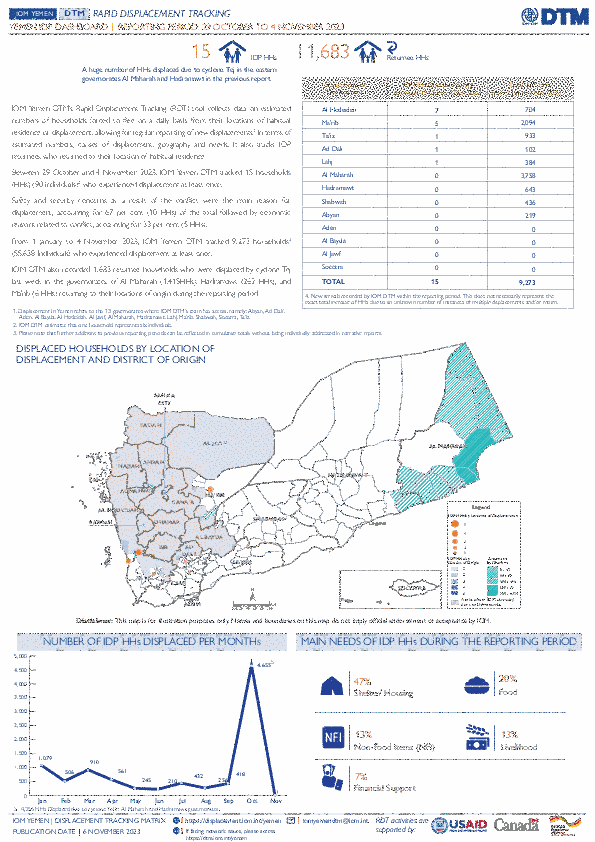-
Countries
-
Data and Analysis
-
Special Focus
-
Crisis Responses
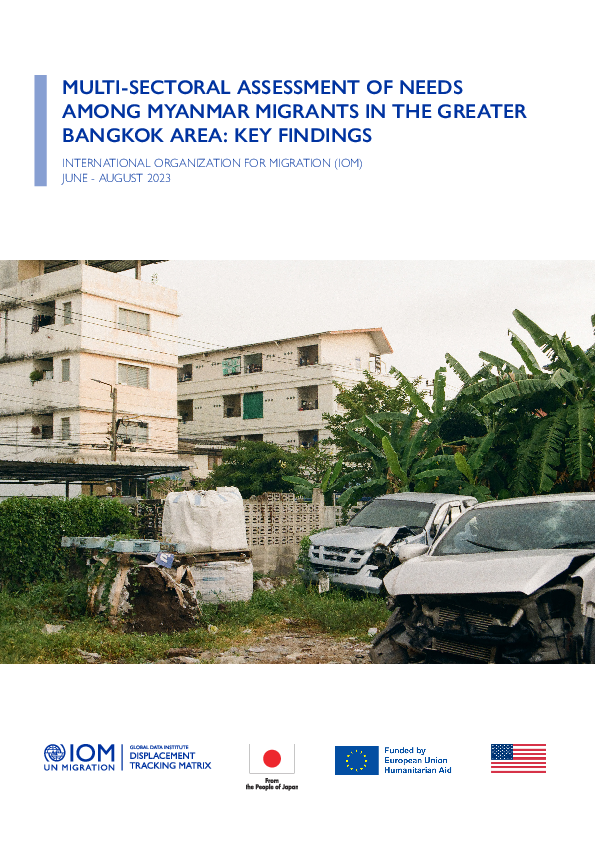
Contact
DTMThailand@iom.int
Language
English
Location
Thailand
Period Covered
Jun 01 2023
Aug 31 2023
Activity
- Survey
- Site Assessment
This report aims to provide details on key findings regarding the multi-sectoral conditions, needs and challenges among the Myanmar migrant population in the Greater Bangkok Area as captured between June to August 2023 by IOM’s Multi-Sectoral Assessment of Needs (MSA). The purpose of this assessment is to provide detailed multi and inter-sectoral analysis of the magnitude and severity of needs among migrant populations, identify vulnerable population groups and geographic areas with the most acute needs, inform development assistance planning and relevant Sustainable Development Goals (SDG) targets, and provide sectoral and inter-sectoral baselines for future assessments. This report includes key findings and related analyses on migration history, economic status, education, employment, health access, and shelter access.
The household survey was answered by 2,260 respondents. The combined number of respondents and their household members is 3,555 individuals.
Contact
DTM Sudan, DTMSudan@iom.int
Location
Sudan
Activity
- Mobility Tracking
- Baseline Assessment
Period Covered
Apr 15 2023 -Oct 25 2023
Overview:
IOM DTM Sudan is pleased to present its second Monthly Displacement Overview. This publication provides an account of Sudan’s displacement context since 15 April 2023 – outlining population caseloads and movements, as well the present and evolving needs of Sudan’s growing IDP caseload.
Rationale:
Recognizing the need for more detailed insights into the IDP situation, including the priority needs, access to services, movement intentions, and demographic breakdowns of the affected population, DTM Sudan has undertaken a comprehensive review of our data collection tool. In collaboration with a wide range of internal and external stakeholders, we have developed a new tool to better inform humanitarian response operations, aligning with the DTM global methodology. Leveraging our extensive network of approximately 300 field-based enumerators and a robust system of over 1500 key informants across the country, DTM has gathered data on IDPs across 5,034 locations, in 168 of Sudan’s 189 localities – across all of Sudan’s 18 states.
Key Findings:
DTM Sudan estimates that 4,856,294 Individuals (967,272 Households) have been recently internally displaced.
IOM DTM also reports that an estimated 1,304,028 mixed cross-border movements have been made into neighbouring countries.
Since 15 April 2023, 44% of the IDP caseload has sought refuge in the Darfur and Kordofan regions, whereas the majority (56%) are observed across the Northern, Eastern, and Central states.
Just over two-thirds of the IDP caseload are seeking shelter with the host community.
While Food Security remains the highest priority need, Health and Non-Food Items are also growing concerns.
A more detailed version of this dataset is available, to get access kindly click on the 'Request Access' button.
Population Groups
IDPs
Migrants Present
Survey Methodology
Unit of Analysis Or Observation
Admin Area 2
Admin Area 3
Admin Area 4
Household
Individual
Site or Location
Type of Survey or Assessment
Key Informant
Keywords
Geographical Scope Full Coverage
Administrative boundaries with available data
The current dataset covers the following administrative boundaries
Contact
DTM Yemen, iomyemendtm@iom.int
Location
Yemen
Activity
- Mobility Tracking
Period Covered
Oct 29 2023 -Nov 04 2023
From 1 January to 4 November 2023, IOM Yemen DTM tracked 9,273 households (HH) (55,638 Individuals) who experienced displacement at least once.
Between 29 October and 4 November 2023, IOM Yemen DTM tracked 15 households (90 individuals) displaced at least once. The majority of people moved into/within the following governorates and districts:
- Al Hodeidah (7 HHs) – Hays (4 HHs), Al Khukhah (3 HHs) districts. All displacements in the governorate were internal.
- Marib (5 HHs) – Marib (4 HHs), Marib City (1 HH) districts. Most displacements in the governorate originated from Amran and Al Hodeidah.
- Ad Dali (1 HH) – Ad Dali (1 HH) district. All displacements in the governorate were internal.
- Al Hodeidah (8 HHs) – Hays (4 HHs), At Tuhayta (2 HHs), Al Mina (1 HH) districts.
- Amran (3 HHs) – Thula (3 HHs) district.
- Taiz (2 HHs) – At Taiziyah (1 HH), Maqbanah (1 HH) districts.
Population Groups
Survey Methodology
Unit of Analysis Or Observation
Type of Survey or Assessment
Keywords
Geographical Scope
Administrative boundaries with available data
The current dataset covers the following administrative boundaries
IOM Yemen DTM’s Rapid Displacement Tracking (RDT) tool collects data on estimated numbers of households forced to flee on a daily basis from their locations of origin or displacement, allowing for regular reporting of new displacements in terms of estimated numbers, geography, and needs. It also tracks returnees who returned to their location of origin.
From 1 January to 4 November 2023, IOM Yemen DTM tracked 9,273 households (HH) (55,638 Individuals) who experienced displacement at least once.
Between 29 October and 4 November 2023, IOM Yemen DTM tracked 15 households (90 individuals) displaced at least once. The majority of people moved into/within the following governorates and districts:
- Al Hodeidah (7 HHs) – Hays (4 HHs), Al Khukhah (3 HHs) districts. All displacements in the governorate were internal.
- Marib (5 HHs) – Marib (4 HHs), Marib City (1 HH) districts. Most displacements in the governorate originated from Amran and Al Hodeidah.
- Ad Dali (1 HH) – Ad Dali (1 HH) district. All displacements in the governorate were internal.
The majority of people moved from the following governorates and districts:
- Al Hodeidah (8 HHs) – Hays (4 HHs), At Tuhayta (2 HHs), Al Mina (1 HH) districts.
- Amran (3 HHs) – Thula (3 HHs) district.
- Taiz (2 HHs) – At Taiziyah (1 HH), Maqbanah (1 HH) districts.
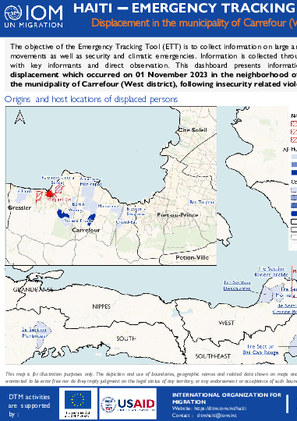
Contact
dtmhaiti@iom.int
Language
English
Location
Haiti
Period Covered
Nov 01 2023
Nov 06 2023
Activity
- Mobility Tracking
- Event Tracking
On 1st November 2023, insecurity related violences erupted in the neighborhood of Mariani Ouest located in the municipality of Carrefour (West District). In addition to loss of life, these attacks have also caused the displacement of approximatively 2,487 individuals (507 households), most of whom headed towards the municipality of Gressier, precisely in the 1st Section Morne à Bateau. All the displaced people took refuge with host families.
In Central America, North America and the Caribbean, the effects of natural disasters, climate change, violence, and insecurity drive internal displacement as people move to seek safety within their own countries. However, the lack of information on internal displacement in some areas of the region limits visibility on the magnitude of this phenomenon and the ability to address its effects. There is a substantial need for official IDP statistics and operational data in the region, including the necessary infrastructure to collect and maintain such data.
DTM activities focused on identifying and tracking internal displacement in Central America, North America and the Caribbean are currently being conducted in Haiti and Honduras. Both countries face a complex internal displacement context shaped by violence and natural disasters. The purpose of this report is to provide an overview of the information available on internal displacement in Haiti and Honduras obtained through data collection activities conducted between August 2022 and October 2023. It will also highlight capacity building efforts to strengthen existing data collection systems and to expand data collection on IDPs into other countries of the region.
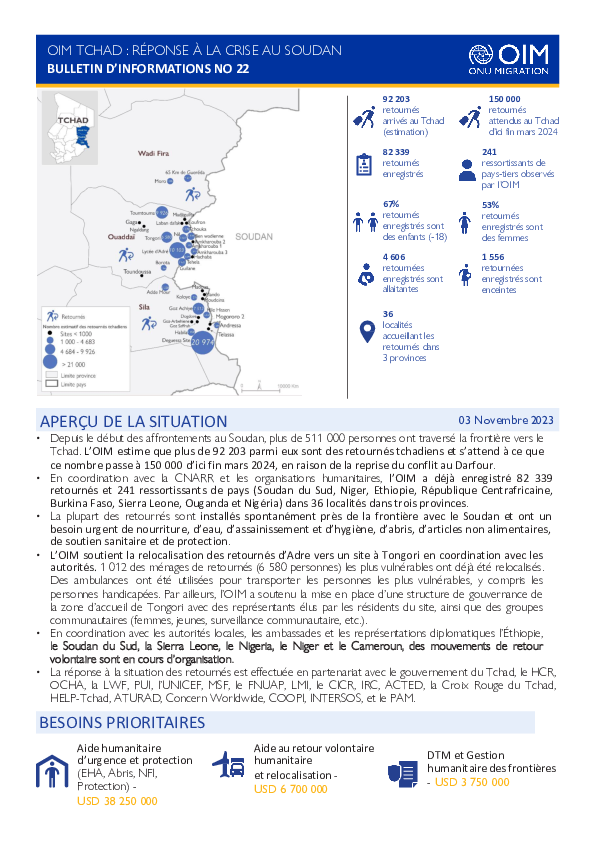
Contact
DTM Chad, dtmtchad@iom.int
Language
French
Location
Chad
Period Covered
Oct 25 2023
Nov 03 2023
Activity
- Survey
- Flow Monitoring Survey
- Flow Monitoring
- Depuis le début des affrontements au Soudan, plus de 511 000 personnes ont traversé la frontière vers le Tchad. L’OIM estime que plus de 92 203 parmi eux sont des retournés tchadiens et s’attend à ce que ce nombre passe à 150 000 d’ici fin mars 2024, en raison de la reprise du conflit au Darfour.
- En coordination avec la CNARR et les organisations humanitaires, l’OIM a déjà enregistré 82 339 retournés et 241 ressortissants de pays (Soudan du Sud, Niger, Ethiopie, République Centrafricaine, Burkina Faso, Sierra Leone, Ouganda et Nigéria) dans 36 localités dans trois provinces.
- La plupart des retournés sont installés spontanément près de la frontière avec le Soudan et ont un besoin urgent de nourriture, d’eau, d’assainissement et d’hygiène, d’abris, d’articles non alimentaires, de soutien sanitaire et de protection.
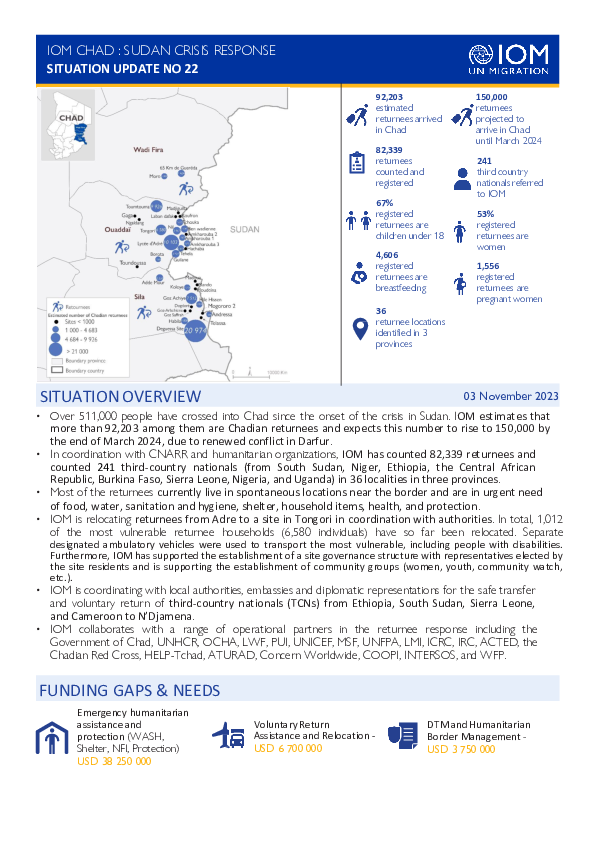
Contact
DTM Chad, dtmtchad@iom.int
Language
English
Location
Chad
Period Covered
Sep 24 2023
Nov 03 2023
Activity
- Survey
- Flow Monitoring Survey
- Over 511,000 people have crossed into Chad since the onset of the crisis in Sudan. IOM estimates that more than 92,203 among them are Chadian returnees and expects this number to rise to 150,000 by the end of March 2024, due to renewed conflict in Darfur.
- In coordination with CNARR and humanitarian organizations, IOM has counted 82,339 returnees and counted 241 third-country nationals (from South Sudan, Niger, Ethiopia, the Central African Republic, Burkina Faso, Sierra Leone, Nigeria, and Uganda) in 36 localities in three provinces.
- Most of the returnees currently live in spontaneous locations near the border and are in urgent need of food, water, sanitation and hygiene, shelter, household items, health, and protection.

Contact
DTMUkraine@iom.int
Language
English
Location
Ukraine
Period Covered
Sep 03 2023
Sep 25 2023
Activity
- Survey
Between 3 and 25 September 2023, the International Organization for Migration (IOM) conducted Round 14 of the General Population Survey (GPS), a highly representative assessment of internal displacement in Ukraine which gathers information on population figures, mobility flows, intentions, and conditions to facilitate evidence-based decision-making on strategic, technical, and programmatic aspects of the response and recovery efforts in Ukraine. Further, Round 14 continues to evaluate durable solutions to internal displacement along criteria proposed by the Inter-Agency Standing Committee Framework on Durable Solutions for IDPs (IASC). This report also includes new sections on winterisation and participation in public affairs. The General Population Survey was constructed through interviews with 20,000 respondents using the computer-assisted telephone interview (CATI) method, and a random digit dial (RDD) approach.
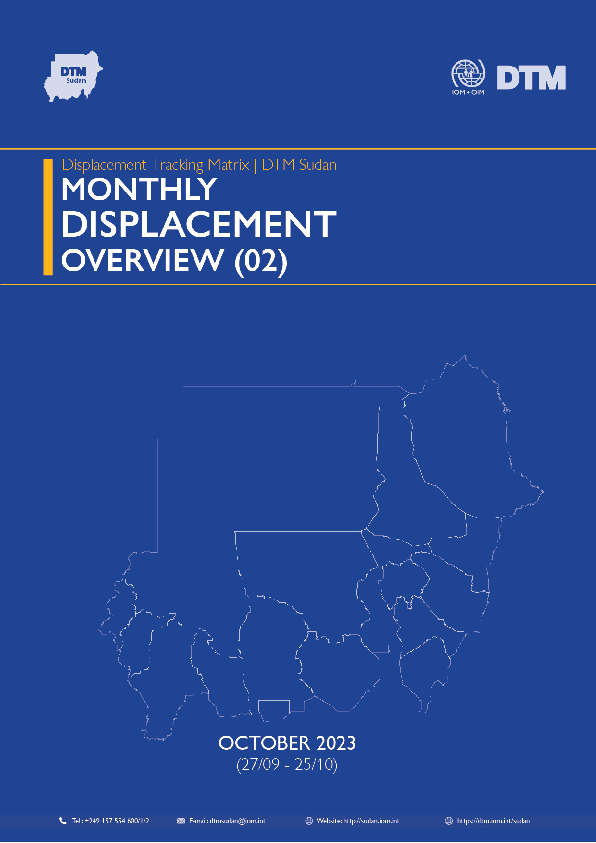
Contact
DTM Sudan, DTMSudan@iom.int
Language
English
Location
Sudan
Snapshot Date
Oct 25 2023
Activity
- Mobility Tracking
- Baseline Assessment
Overview
IOM DTM Sudan is pleased to present its second Monthly Displacement Overview. This publication provides an account of Sudan’s displacement context since 15 April 2023 – outlining population caseloads and movements, as well the present and evolving needs of Sudan’s growing IDP caseload.
Rationale
Recognizing the need for more detailed insights into the IDP situation, including the priority needs, access to services, movement intentions, and demographic breakdowns of the affected population, DTM Sudan has undertaken a comprehensive review of our data collection tool. In collaboration with a wide range of internal and external stakeholders, we have developed a new tool to better inform humanitarian response operations, aligning with the DTM global methodology. Leveraging our extensive network of approximately 300 field-based enumerators and a robust system of over 1500 key informants across the country, DTM has gathered data on IDPs across 5,034 locations, in 168 of Sudan’s 189 localities – across all of Sudan’s 18 states.
Key Findings
- DTM Sudan estimates that 4,856,294 Individuals (967,272 Households) have been recently internally displaced.
- IOM DTM also reports that an estimated 1,304,028 mixed cross-border movements have been made into neighbouring countries.
- Since 15 April 2023, 44% of the IDP caseload has sought refuge in the Darfur and Kordofan regions, whereas the majority (56%) are observed across the Northern, Eastern, and Central states.
- Just over two-thirds of the IDP caseload are seeking shelter with the host community.
- While Food Security remains the highest priority need, Health and Non-Food Items are also growing concerns.
